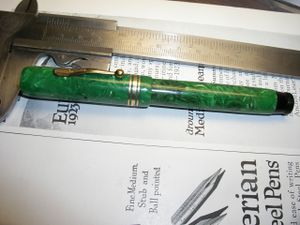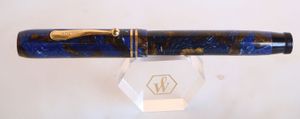Differenze tra le versioni di "Chilton/en"
(Creata pagina con 'Crocker produced good quality pens and its the filling system was effective, even if it was somewhat uncomfortable to use; so soon it was replaced by the so-called ''[[hat...') |
(Creata pagina con 'In 1923 ''Seth Chilton Crocker'' entered directly in the fountain pen market founding in Boston a new company with its own name: the ''Chilton Pen Company''. The following yea...') |
||
| Riga 9: | Riga 9: | ||
[[Crocker]] produced good quality pens and its the filling system was effective, even if it was somewhat uncomfortable to use; so soon it was replaced by the so-called ''[[hatchet filler]]'', a loading system realized using a lever attached to the back of the pen, made in this way to circumvent [[Sheaffer]] patents. ''Seth Crocker'' left the business in 1920 and his son, ''Seth Crocker Chilton'' took over the conduct of the company that was moved from Boston to New York. | [[Crocker]] produced good quality pens and its the filling system was effective, even if it was somewhat uncomfortable to use; so soon it was replaced by the so-called ''[[hatchet filler]]'', a loading system realized using a lever attached to the back of the pen, made in this way to circumvent [[Sheaffer]] patents. ''Seth Crocker'' left the business in 1920 and his son, ''Seth Crocker Chilton'' took over the conduct of the company that was moved from Boston to New York. | ||
| − | + | In 1923 ''Seth Chilton Crocker'' entered directly in the fountain pen market founding in Boston a new company with its own name: the ''Chilton Pen Company''. The following year he launched the first model of the new company. It was a ordinary ''[[flattop]]'' hard rubber pen, but it was using an ingenious [[pneumatic filler|pneumatic filling system]] evolved from the ''[[blow filler]]'' invented by his father. That mechanism was essentially a precursor of the ''[[touchdown filler]]'' that [[Sheaffer]] will introduce just over 20 years later. | |
Il [[caricamento pneumatico|sistema di riempimento pneumatico]] della [[Chilton]] è basato sulla compressione effettuata tramite lo scorrimento del fusto esterno della penna su un cilindro metallico interno che racchiude il sacchetto di inchiostro della penna. Il fusto è fornito di un foro sul fondo da tenere chiuso con un dito in fase di compressione, una volta aperto si consente l'espansione del sacchetto ed il conseguente caricamento. | Il [[caricamento pneumatico|sistema di riempimento pneumatico]] della [[Chilton]] è basato sulla compressione effettuata tramite lo scorrimento del fusto esterno della penna su un cilindro metallico interno che racchiude il sacchetto di inchiostro della penna. Il fusto è fornito di un foro sul fondo da tenere chiuso con un dito in fase di compressione, una volta aperto si consente l'espansione del sacchetto ed il conseguente caricamento. | ||
Versione delle 19:34, 8 mar 2012
Chilton and Crocker are two of the most interesting between the many companies born in the golden age of American fountain pen that disappeared with the difficulties encountered in subsequent years. The first was created by the son of the founder of the second, that was absorbed in it. Past the golden age of the '20s Chilton, like most other producers of the time, suffered heavily the great depression of 1929. In the '30s sales deteriorated, and production continued to decline until the final exit from the market in 1941.
Despite the high quality of its fountain pens, certainly not lower that of the far more famous Waterman, Sheaffer and Parker, Chilton never shone for in marketing capabilities: the spread of its pens never came out of the United States, and in the USA the distribution remained localized in the North East of the country. Chilton pens were beautiful, functional and with great technical quality, but because of their low diffusion they did not had the success they deserved; therefore are quite rare and much sought by collectors.
| Chilton |
|---|
| Brand pages |
| Brand photos |
| Instructions sheet |
| Patents |
In 1902 Seth Sears Crocker founded in Boston the Crocker Pen Company. At that time companies were founded almost always following the completion of some technical innovation, for Crocker this was a new filling system called blow filler as based on compression of a rubber sac to be carried out by blowing into the body of the pen by a hole on the bottom.
Crocker produced good quality pens and its the filling system was effective, even if it was somewhat uncomfortable to use; so soon it was replaced by the so-called hatchet filler, a loading system realized using a lever attached to the back of the pen, made in this way to circumvent Sheaffer patents. Seth Crocker left the business in 1920 and his son, Seth Crocker Chilton took over the conduct of the company that was moved from Boston to New York.
In 1923 Seth Chilton Crocker entered directly in the fountain pen market founding in Boston a new company with its own name: the Chilton Pen Company. The following year he launched the first model of the new company. It was a ordinary flattop hard rubber pen, but it was using an ingenious pneumatic filling system evolved from the blow filler invented by his father. That mechanism was essentially a precursor of the touchdown filler that Sheaffer will introduce just over 20 years later.
Il sistema di riempimento pneumatico della Chilton è basato sulla compressione effettuata tramite lo scorrimento del fusto esterno della penna su un cilindro metallico interno che racchiude il sacchetto di inchiostro della penna. Il fusto è fornito di un foro sul fondo da tenere chiuso con un dito in fase di compressione, una volta aperto si consente l'espansione del sacchetto ed il conseguente caricamento.
Il sistema era semplice, funzionale e robusto, e consentiva di utilizzare sacchetti di gomma di dimensioni nettamente superiori rispetto a quelli dei concorrenti, tanto che le penne venivano promosse con lo slogan Twice the ink. A causa però della maggiore lunghezza del gruppo pennino, resa necessaria dalla particolare struttura del sistema di caricamento, la forma delle penne era poco proporzionata per la corrispondente maggior lunghezza del cappuccio.

Le prime penne della Chilton vennero realizzate in ebanite nera o fiammata, ma già a partire dal 1926 vennero introdotti dei nuovi modelli costruiti in celluloide, nei classici colori Jade green e Pearl Black. Nei primi anni tutta la produzione della Chilton proveniva dagli impianti di Boston, ed i modelli di questo periodo sono spesso indicati con il nome di questa città.
Alla fine degli anni '20 (il momento esatto del trasferimento è incerto, taluni lo indicano nel 1926, altri nel 1929) la Chilton trasferì gli impianti produttivi da Boston a Long Island (New York) inglobando anche i resti della Crocker. In questo periodo vennero prodotti nuovi modelli in celluloide con nuovi colori, e sviluppata una seconda versione del sistema di caricamento, in cui non era più il fusto esterno ad essere usato per la compressione, ma un contro-cappuccio metallico azionato tramite il fondello. In questo modo le dimensioni del cappuccio potevano tornare ad essere più proporzionate.

All'inizio degli anni '30 vennero anche adottate, seguendo lo stile streamlined introdotto dalla Balance, delle forme affusolate. I modelli di questo periodo, prodotti in 15 variazioni di colore ed 8 dimensioni diverse vengono comunemente chiamati Long Island. Si attribuisce più o meno questo periodo anche la nascita dei modelli cosiddetti Lox-Top per il particolare meccanismo che impediva che il cappuccio potesse svitarsi quando la penna era inserita nel taschino, cosa che veniva realizzata tramite un piccolo perno, azionato dal fermaglio, che andava a bloccarsi sulla sezione quando questo veniva spostato dalla stoffa della tasca.
Fra il 1934 ed il 1935 (di nuovo vengono riportate queste due date da fonti diverse) la Chilton introdusse quello che è probabilmente il suo capolavoro, il modello Wing-flow. Il nome della penna derivava dal peculiare pennino, il cui brevetto (nº US-2089449) venne richiesto nel 1935, dotato di alette ribattute intorno all'alimentatore, così che questo non potesse disallinearsi.
Nel 1939 la Chilton produsse la sua ultima penna di qualità, la Golden Quill, introdotta sul mercato in occasione della Fiera Mondiale di New York. La nuova penna era contraddistinta da uno stile semplice ed austero, in netto contrasto con l'opulenza della Wing-flow. La qualità come sempre era impeccabile, ma l'azienda era ormai in crisi e la nuova penna non venne pubblicizzata a sufficienza: le vendite furono scarse (tanto che la penna è molto rara ed oggi ricercatissima dai collezionisti).
Nel 1941, dopo aver introdotto sul mercato penne economiche di bassa qualità (le Chiltonian, vendute per lo più per corrispondenza), la Chilton, incapace di generare vendite sufficienti, chiuse i battenti uscendo definitivamente dal mercato.
Template:CronoMarche |- | 1902 || Nascita della Crocker Pen Company |- | 1923 || Nascita della Chilton Pen Company |- | 1925 || Lanciato il primo modello di Chilton a riempimento pneumatico (o 1924) |- | 1926 || La Chilton si sposta da Boston a Long Island a New York |- | 1926 || Introduzione di modelli in celluloide |- | 1927 || Introdotto il secondo modello di riempimento pneumatico |- | 1930 || Introdotta la Rocker clip |- | 1935 || Introdotto il modello Wing-flow |- | 1936 || Introdotte le iniziali a intarsio sulla Wing-flow |- | 1937 || Brevettato il Lox-Top |- | 1937 o 38 || La Chilton si sposta a Summit, nel New Jersey |- | 1939 || Introdotto il modello Golden Quill |- | 1941 || Chiusura della Chilton |- |}
Template:LegendaModelli |- | Lox-Top || 193x || XX, ? |- | Wing-flow || 1935 || XX, ? |- | Golden Quill || 1939 || XX, ? |- |}
Riferimenti esterni
- http://www.chiltonpens.com/
- http://www.rickconner.net/penspotters/chilton.html
- http://www.billspens.com/billspens/chilton/chilton.htm
- http://www.achaikin.com/chiltons.html
- http://www.pensandwatches.com/_pages/pen_company_photos/Chilton_pen_company.htm
- http://www.fountainpennetwork.com/forum/index.php?showtopic=113812
- http://sanchezalamopens.blogspot.com/2009/05/espanol-crocker-pen-company-was-founded.html
- http://sanchezalamopens.blogspot.com/2009/10/hoy-en-dia-las-estilograficas-chilton.html
- http://kamakurapens.invisionzone.com/index.php?showtopic=248